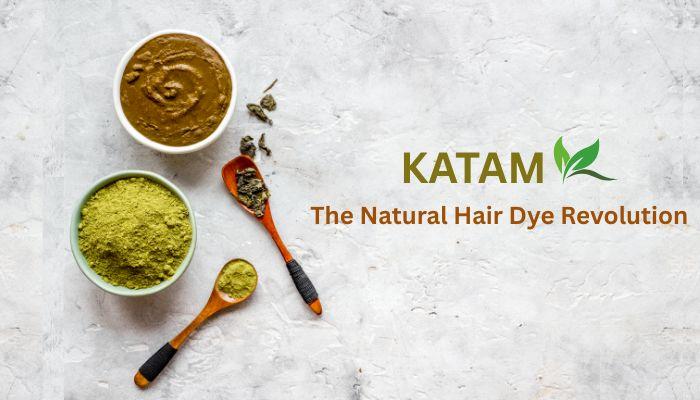The contemporary hair care industry shows increasing interest in natural and sustainable solutions because numerous individuals choose to abandon chemical dyes. Katam serves as a natural plant-based hair dye that produces intense color results while protecting hair health and maintaining its effects for a long time. Katam is known as “black henna” because it can provide an intense color, unlike any other. It has a different, unique purple undertone. Katam, which grows in Yemen (Buxus dioica), has been used for centuries as a dye to help create truly memorable deep dark hair colors. This article will explain what katam is, the benefits of katam, and reveal how to use katam on hair to achieve naturally beautiful results that are highly effective for grey coverage and darker shades.
What is Katam?
Katam, or Buxus dioica, is a natural hair dye derived from the katam plant leaves that grow in the high mountains of Yemen. Katam is a natural hair dye and does not contain any chemicals (like synthetic hair dyes, which usually require ammonia, hydrogen peroxide, and other various additional chemicals). Katam is a 100% natural product that produces a hair color by staining the outside layer of each strand of hair (the outer layer of the hair doesn’t become damaged like in the process of dyeing with synthetic hair coloring). People often describe katam as a dark green powder that produces a nearly black color with visible violet or purple highlights, which is different from other plant dyes like henna and indigo. Katam has been frequently referred to as “black henna”, but they are distinctly a different herb with unique properties, and katam should not be described as indigo (and addressed as the “real” henna), which primarily produces cool, blue-shaded hair colors.
The worldwide limited availability of Katam establishes its status as an exclusive component for natural hair products. The scarcity of Katam combined with its challenging harvesting method drives its price higher compared to henna and indigo. Leaves are harvested and dried, then sifted 3 times until they become an excellent powder. This can then be mixed as a paste with water or other liquids to be applied to hair. Katam has a special property to produce dark brown to black shades with a purple sheen, attractive to natural hair colors who want to avoid the damaging effects of chemical dye.
Also Read: Parijat Leaves Benefits: Amazing Health Advantages You Didn’t Know
Historical and Cultural Importances
Katam has been in use for hundreds of years, especially in Yemen and different parts of the Middle East, where it is strongly affiliated as a traditional product and cultural beauty product. In its traditional context, Katam was used by both men and women to naturally enhance hair color, cover grey, and improve hair texture. Today, Katam can be used to highlight the eco-consciousness and health-consciousness in beauty products, as well as highlight modern hair care treatments requested by consumers. Katam and other natural hair dyes align with the growing demand for better products that consumers feel confident applying to their health. Katam can also be dual-purpose as it helps condition and strengthens hair while coloring. Whereas synthetic hair coloring can strip hair of conditioning due to toxic ingredients and leave the scalp damaged through all the strong chemicals, katam is a fresh alternative to achieve hair color while helping condition and nourish hair safely.
Benefits of Katam for Hair

There are many benefits to using katam as a hair color that makes it appealing to individuals who prioritize using natural and sustainable options when it comes to hair care. Here are a few advantages:
- 100% Natural and Harmless: Atam does not contain dangerous chemicals such as ammonia, sodium picramate, and heavy metals that are typically found in commercial hair color. It is made from plants with very little risk of allergic reaction (although a patch test is always recommended before trying anything for the first time).
- Covers Grey and White Hair: Katam also excels at covering gray or white hair and providing lasting color. Katam can produce dark brown colors with purple tones – if mixed with henna. For individuals seeking to band-aid the greys without turning to synthetic, manufactured dye, katam is an excellent option.
- Strengthening and Conditioning: In addition to dyeing hair, katam also makes hair strong, which reduces hair loss, and makes hair glossier and more elastic. The conditioning is why hair remains soft and flexible, lustrous and shiny. It’s a natural holistic solution for caring for your hair.
- Long-Lasting Color: The hair treatment Katam delivers bright and enduring semi-permanent colors to the hair. The hair color from katam remains vibrant for up to three months depending on individual hair characteristics. The initial two washes will cause color bleeding but the dye becomes stable afterward. The results produced by Katam maintain high levels of consistency.
- Unique Color Profile: Katam offers a dark brown to near-black color with violet or purple highlights when dipped in sunlight. Indigo creates black colors with blue undertones, while katam delivers a more vibrant shade that works best with both cool and warm color palettes.
- Eco-Friendly and Sustainable: The production of Katam comes from vegetation which thrives in arid desert-border environments thus making it an environmentally sustainable choice. The cultivation of Katam functions as a tool for fighting desert expansion while providing economic opportunities to impoverished communities. Katam’s production avoids the potential environmental harm low-level synthetic dyes can bring to the ecosystem.
How to Use Katam on Hair
The application of katam on hair demands proper preparation along with mental preparation to reach specific color targets and optimal outcomes. The application methods for katam on hair vary because they depend on both hair characteristics along with the intended color results and combination with other natural dyes including henna and indigo. The following section provides an outline regarding the correct use of Katam together with advice about both single-step and two-step techniques.
Materials Needed
Before starting your project you must obtain these essential materials:
- Pure Katam powder: Select only premium pure katam powder from trustworthy suppliers to guarantee genuine results.
- Henna Powder (optional): This two-step process component enables users to intensify color results.
- Indigo Powder (optional): Utilized for achieving blackish-purple undertones in darker color results.
- Warm Water or Black Tea: Needed to mix the katam paste. You can use black tea, which can enhance depth.
- Lemon Juice (optional): Used to help release the dye if you are also using henna (not commonly used!).
- Plastic or Glass Bowl: Avoid using metal as it can react with the dye pigment.
- Plastic or Wooden Spoon: To mix the paste.
- Gloves: To keep hands from being stained.
- Shower Cap or Plastic Wrap: To keep the paste moist during processing.
- Clingfilm or Aluminum Foil (optional): To wrap hair to avoid drying.
- Sulfate-Free Shampoo and Conditioner: Use after applying the katam to maintain color.
Preparation Tips
- Hair Preparation: Before starting the hair coloring process you should cleanse your hair using clarifying shampoo to remove sebum and dirt and product buildup that blocks dye penetration. Avoid using any conditioner because it creates a barrier. For extremely oily hair you should use dish soap because it will give you the cleanest starting point.
- Patch Test: Evaluating the katam through a brief test behind the ear will reveal potential allergies and uncommon color changes because inferior quality katam sometimes results in green or blue hair outcomes for particular people.
- Storage: Proper storage of katam powder requires a cool dark environment or freezer space to maintain its maximum strength. The paste form of katam differs from henna because it requires immediate use after preparation since remaining paste becomes ineffective.
Single-Step Application: Achieving Brown Tones
The application of katam requires a single-step process as it provides gentle brown tones with purple undertones, which can be combined with henna.
- Mix the Paste:
- The first step involves mixing 40% katam powder with 30% henna powder and 30% cinnamon powder in a bowl to create the desired shade. To create basic brown tones, you need to blend katam with warm water or black tea until the mixture reaches a creamy consistency.
- A small amount of baking soda can be added to the liquid to increase dye release if desired.
- During the 1-2 hour resting period you should stir the mixture regularly to maintain consistent texture.
- Apply to Hair:
- Before applying the paste section, clean hair, which is towel-dried, and then start from the back while using gloves to prevent staining from the product.
- Apply the paste evenly across your hair by focusing particularly on roots and grey strands.
- Process:
- The paste requires moisture retention; thus, you should cover your hair with either a shower cap cl, clingfilm, or aluminium foil.
- The application period should last between 40 and 120 minutes to achieve the color you want. A shorter application time produces lighter brown shades, while extended periods result in deeper color development.
- Wash Out and Care:
- Rinse with lukewarm water until all water runs clear. Skip shampooing on the first wash so that the color can remain.
- Use sulfate free shampoo and conditioner on subsequent washes.
This method works well for clients who have health issues or limited time because it is only one application. The less intense result than a two step, this method creates a light to dark brown with some subtle purple highlights.
Also Read: Kalonji Seeds Benefits: A Natural Remedy for Better Health
Two-Step Application: Achieving Dark Brown to Black with Purple Undertones
For darker results, especially on grey or white hair, we recommend a two-step process using henna followed by katam.
- Step 1: Henna Application:
- Mixing henna powder with warm water and lemon juice will create a paste. After 30 minutes the mixture will be ready to use.
- Apply to clean, towel-dried hair ensuring all the hair is covered, especially grey hair.
- Wrap hair and let the henna sit for 1 – 4 hours based on the desired base color (red to auburn).
- The water should be lukewarm for a complete rinse until the water becomes clear.
- Step 2: Katam Application:
- Right after rinsing out the henna, mix katam powder with warm water or black tea to make a creamy paste; USE WITHIN 10-15 MINUTES because katam paste does not store well.
- Apply to hair, ensuring even coverage, and wrap with a shower cap or foil.
- Leaving on for 4 – 5 hours for dark brown or near-black shades, which will have purple undertones as well. If a blacker result is desired, it may take two or three times of application.
- Rinse and Care:
- Use lukewarm water to rinse thoroughly while avoiding shampoo during your initial wash.
- The color needs 48 hours to oxidize fully, so what you see in the first wash is not the final product.
- We would urge you to ensure sulfate-free products to ensure the longevity of the color.
This technique is particularly beneficial for grey hair due to henna providing a base for katam to reach deeper, darker tones.
Combining Katam with Indigo
For those seeking very dark or black hair with purple highlights, katam can be mixed with indigo in a single or two-step process. A common ratio is 50% katam and 50% indigo, mixed with warm water and applied after a henna base. This combination yields a deep black with violet undertones, distinct from indigo’s blue-black results.
Tips for Best Results
- Do not use oils or food: Avoid using oils or food because katam should never be combined with oils or food items since oils prevent color absorption while food items will consume the color resulting in muddy katam.
- Quality control: Some katam is of very poor quality, mixed with indigo or synthetic dyes. The color can come out very unexpectedly, like blue or green! Always purchase only from a trusted source and verify it is pure.
- Texture: The katam paste can be grainy and hard to apply. Adding small amounts of baking soda or utilizing a finer-sifted powder can improve the all-around color application.
- Color development: Katam gets darker over 48 hours; it is a matter of oxidation. The shade you see initially is not the final product because it will lighten the first two washes and then look pretty stable after that. Be patient.
- Root touch up: Do root touch-ups on a 4 – 6-week basis, depending on your speed of growth. It is important to note that regular application of katam can improve color depth and hair health over time.
Challenges and Considerations
While katam is a tough and powerful natural dye, it does come with challenges:
- Texture Problems: When applying katam paste, it is often grainy. Henna paste is usually much smoother, which leads me to believe it can be problematic since some users have indicated katam crumbles or falls out during processing. More suppliers are making an effort to sift finer to improve this issue.
- Cost and Selling Issues: Katam naturally is rare. So pricing is higher than henna or indigo. Supply chain problems coming out of Yemen limit availability from suppliers.
- Gray Hair Issue: When applying to grey hair without a henna base, the result will likely be dark grey, which you don’t want. End results vary depending on hair type or climate conditions.
- Allergies: Allergic reactions from users are rare. It’s better to do a patch test for allergies before full application.
- Unpleasant Odour: Katam has a strong, unappetizing smell, fermented in nature. If you are using only katam it is complaining to many users.
Katam vs. Indigo: Key Differences
Katam is often compared to indigo because they both provide a way to darken the red tones of henna, but the differences extend further than just color:
- Color Outcome: Katam is capable of providing warm shades of brown to black with purple/violet undertones. Indigo, on the other hand offers cool, blue-black tones.
- Fading: Katam is more fade-resistant than indigo, which tends to wash out faster (especially on grey hair).
- Application: Katam has a lighter dye release time (10-15 mins) compared to indigo but may be more difficult to apply due to its grainy texture.
If you are looking for a warmer, purple-toned result, then katam is your best option, but if you want a cooler, blue-black result, indigo is a suitable alternative.
Future of Katam in Hair Care
As the demand for natural beauty products continues to grow, katam is ready to be another mainstream component of environmentally friendly haircare. The rapid improvement of sifting and processing to improve texture is making it more user friendly. The increase in cultivation from Yemen and other regions can improve stock availability and lower costs. Katam provides brilliant, long-lasting color while also strengthening hair, and corresponds with the global shift from chemical-based beauty to more sustainable and chemical-free solutions.
Conclusion
Katam is much more than a natural dye for hair. It is a combination of rich color and hair health benefits and is also environmentally friendly. Katam can be used as a stand-alone product for brown shades or can be combined with henna and indigo to create deeper, blacker shades and purple highlights. Katam is a safe and effective alternative to chemical dyes. Katam, if properly prepared and applied, can produce fabulous, long-lasting results and also nourish hair at a micro-level. Katam, as well, will have its moment in the beauty industry now that natural solutions are gaining traction. Katam will add to plant-based hair care and offer a vibrant, environmentally conscious way to color and treat hair.



